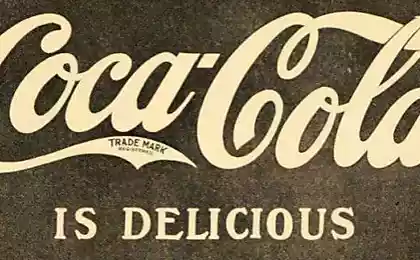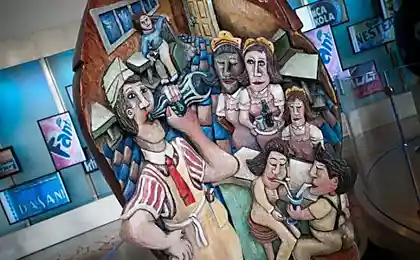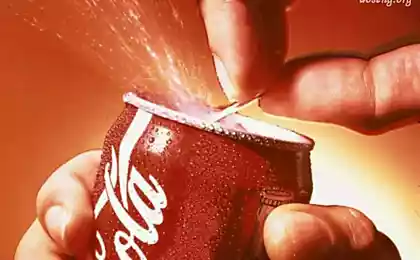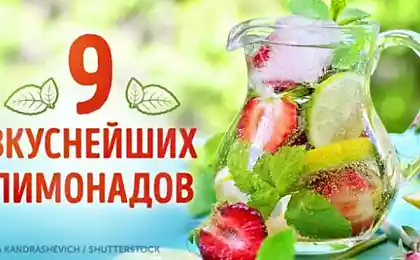1817
History of soda water
Modern mass culture and the process of globalization can not be imagined without a refreshing beverage.

The healing properties of mineral water with gas already knew four thousand years ago in ancient Greece and ancient Rome. The great scientist Hippocrates, in his treatise "On Airs, waters and places" writes that in patients treated with fonts in churches. Greek priests strictly guarded their secrets, protecting the healing power of mineral water.
The discovery of the secret of sparkling water was as unexpected as most of the great discoveries.
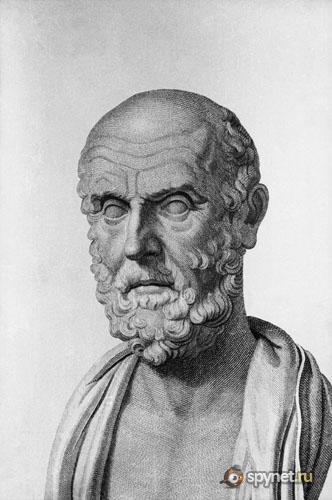
English scientist Joseph Priestley (1733-1804 gg.) Living next door to the brewery and watching her work, interested in what kind of beer bubbles highlights during fermentation. Then he hoisted the two containers with water on cooking with beer. After a while the water is recharged beer with carbon dioxide. Try to get the liquid, the scientist was struck by her unexpectedly pleasant sharp taste and in 1767 he produced the first bottle of soda water.
In 1772 for the discovery of soda Priestley he was admitted to the French Academy of Sciences, and in 1773. - Received the Medal of the Royal Society.
It was the first time Priestley hydrogen chloride, ammonia, fluoride, silicon, sulfur dioxide ...
The name is associated Priestley another wonderful invention, without which it is impossible now to imagine the life of the modern student or student. Priestley accidentally discovered that raw natural rubber is able to erase the traces of graphite (pencil) is better than the particles of bread, which were used at that time for the same purpose. This advantage of the rubber due to the fact that its friction on the paper produces an electrostatic voltage which allows the particles to attract the rubber particles of graphite. So was born the well-familiar eraser.

And in 1770 the Swedish chemist Thorburn Olav Bergman (1735- 1784). Invented a device with which it was possible to produce a soda in large enough quantities. This device is called soda fountain.
Further development in this area has produced Johann Jacob Schweppe, a German by birth, who was holding a jeweler's shop in Geneva. He dreamed of creating a youth non-alcoholic champagne - with bubbles, but without the alcohol. 20 years of experiments were unsuccessful, and in 1783 he invented the industrial plant for the production of carbonated water. Schweppe sold his first drink in Switzerland, but soon realized that in England the demand for it will be higher, and in 1790 moved there. The English were known for their passion for the brand and Schweppe expected to fill its production gap diluents brandy.
Johann Jacob Schweppe founded «J. Schweppes & Co ", which quickly gained momentum, and its drink has won such popularity that produce" soda "rushed to all and sundry. However, to beat the company's products in quality, no one could. In 1831 Schweppes became the supplier of soda for the royal court.
In 1834, J. Schweppes & Co was bought by John Kemp-Welch and William Evillom, who joined the company's range of flavored carbonated beverages.
In the 1870s, it began production of brands Tonic Water and Ginger Ale. Popularity of the first lot has contributed to the geopolitical situation. Great Britain had a variety of colonies in different parts of the world, and the military stationed there often suffer from malaria. A good preventive measure was considered as quinine, but to use it in its pure form was unpleasant because of the bitter taste. The Schweppes invented to mix quinine, oranges and sugar in one drink. Tonic liked the military, especially in India, as quenches thirst and simultaneously protected from malaria.
In 1886, Schweppes was transformed into a limited liability company, and in 1897 issued its first shares to the public.
In XX century the growth of the company continued. By the beginning of World War II, Schweppes became the undisputed leader among the British manufacturers of soft drinks. The war, of course, slowed down the development of the company, but in 1948 the sales volume exceeded the pre-war figures Schweppes.

In the future, the process of inventing new flavors and beverages purchased avalanche, and trendsetters often became pharmacists and pharmacists. In 1875, an American pharmacist Charles Hires HayrsCharles met with drinks produced artisanal way from the roots of some plants - ten years later Hayrs began selling bottled non-alcoholic "root beer" root beer (tastes like root tincture alteynogo).
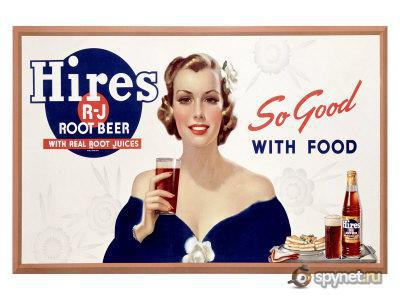
In 1886 were first put on the market and the existing ones - Coca-Cola and Dr. Pepper. Initially, Coca-Cola is made from the infusion of coca leaves and kola nuts, pharmacist John Pemberton invented the recipe PembertonJohn syrup for treating headaches and colds and guessed dilute it with carbonated water. Author of numerous books on the history of the most popular soda millennium, constantly bring fun fact: in the first year through the sale of "coca", could fetch $ 25, while advertising a new drink was spent $ 75.
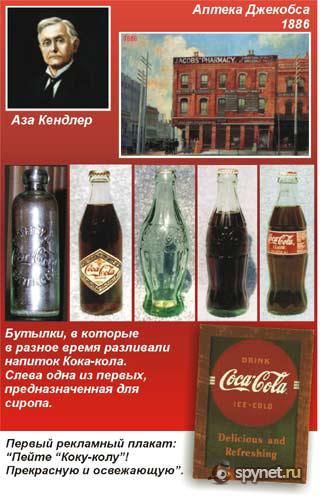
Dr. Pepper was also a figment of the imagination of the pharmacist (his name was Wade MorrisonWade Morrison) and chemist (LezenbiRobert Robert Lazenby). Dr. Pepper, created on the basis of cherry syrup, first produced in the pharmacy (in Waco, Texas), selling it under the slogan "King of non-caffeinated beverages" King of Beverages, Free from Caffeine "(caffeine was added later). According to legend, the name of Dr. Pepper - "Dr. Pepper" is derived from the name of a military doctor who once forbade enterprising Morrison to marry his daughter.

In 1898 there was a Pepsi-Cola (on some versions, initially - a cure for intestinal disorders), which was invented by pharmacist Caleb BredhemomCaleb Bradham, a mixed extract of kola nuts, vanilla and aromatic oils. At the beginning of the 20th century there were also other drinks that are still standing on the shelves of US stores, in particular - Royal-Crown Cola and Canada Dry Ginger Ale. In 1906 it was the first from the American advertising campaign lemonade - Clicquot Club Ginger Ale, named after the celebrated brand of champagne "Veuve Clicquot".
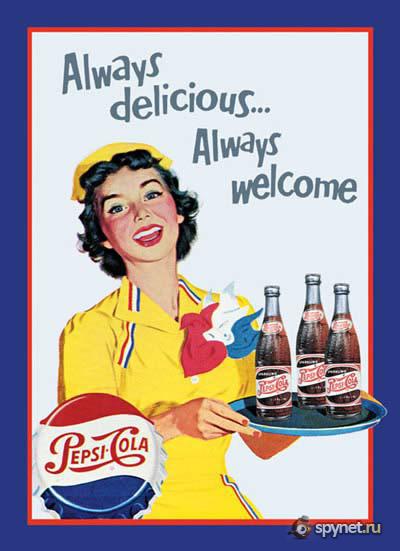
Yet flavored soda, in all probability, was conceived on the western shore of the Atlantic. In 1807 it coined the Philadelphia physician physicist Philip Singh. It is prescribed to patients ennobled syrup, carbonated water, which is produced by its prescription pharmacist Townsend Speakman. Soon, American cities were the first soda kiosks, but widespread it has not received. Available to the Americans its technology was primitive, and the machine Schweppe remained secret.
The success of soda has been very dependent on political factors. After the First World War, the industry was paralyzed - reason was the shortage of sugar. Manufacturers were in serious condition, because the US government has recognized the importance of their product for a healthy diet of Americans. Curiously, a similar decision was taken, and the US government during World War II, but by this time the Americans are addicted to this kind of drink, so in the diet of American soldiers were carbonated beverages. Mark PendergrastMark Pendergrast, author of the book "For God, Country and" Coca-Cola "For God, Country, and Coca-Cola: The Definitive History of the Great American Soft Drink and the Company That Makes It, notes that American soldiers on the front could be a problem of ammunition and bandages, but he always delivered in time to put the bottle with the "coca".
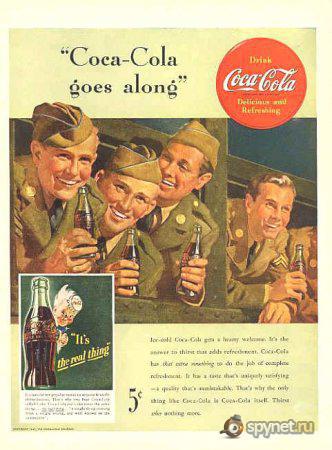
SamuelsonJames James Samuelson, author of "History of Booze" The History of Drink, notes that push in the opposite direction gave the "dry law" - a ban on the sale of alcoholic beverages, which operated in the United States in the years 1920-1933. Consumers were forced to replace the traditional wine and whiskey innocent soft drinks.
In 1929 the United States began an unprecedented economic crisis, "Great Depression", which destroyed many small companies specializing in the production of such goods. However, major players survived. Also in 1929 he was invented lemonade Lithiated Lemon, which is now known under the brand 7Up. After the end of the "dry law" its producers have begun advertising the lemonade is a great tool for creating alcoholic cocktails - thanks to the 7Up has experienced the most difficult years. Further in the case involved the inventors: they have perfected the process of mixing the syrup and carbonated water (the first, in 1922, it has made Coca-Cola), to establish control over the quality of products (before drinks sold under the same brand, but made in different cities, They were often different taste) and also created original packaging (bottles).

1950 marked the beginning of a new era - the appearance of "healthy" drinks. First, high-calorie and unacceptable for certain categories of patients, sugar began to replace artificial sweeteners. In 1952, a small New York company Kirsch Beverages launched the first Lemonade designed for diabetics - No-Cal Ginger Ale (it saccharine sugar substitute). In 1962, throughout the United States have begun selling Diet-Rite Cola (manufacturer Royal Crown Company), which was sweetened cyclamate. In 1963 there was a Coca-Cola Tab, and in 1965 - Diet Pepsi. Much chemistry has made a significant contribution to the business. In the 1980s, manufacturers began to massively use aspartame (made under the name Nutra-Sweet), and in the late 1990s - sucralose (sold under the brand name Splenda). At the beginning of the third millennium, a trendsetter in this field - the company Coca-Cola Co and PepsiCo, as well as their many competitors - have launched low-calorie soda. In many ways, the move was due to the enormous popularity of the Atkins Diet, the essence of which is to avoid the carbs.
In 1960, a new class of drinks - "sport". The pioneer was the Gatorade, whose recipe was developed by the University of Florida FloridyUniversity commissioned by the university's football team coach, which bore the name Gator. This and similar drinks do not contain gas instead they are rich in vitamins and other substances that are supposed to help the athletes to quench their thirst and improve results.

In the 1980s, there were drinks that do not contain caffeine. Initially this was done in order to attract certain groups of the US population, who for various reasons could not use traditional caffeinated soft drinks - for example, children with hypertension or adherents of certain religious cults.
At the same time made drinks with a high caffeine content - their creators hoped to attract students, business people and all the people who urgently needed to cheer up (it is known that in the cup of coffee contains twice as much caffeine than ordinary soft drinks - the new version of lemonade, in particular, Jolt Cola destroyed this advantage of coffee). In the 1990s, there was a logical extension - "energy drinks" (the pioneer was the Red Bull), which contained horse doses of caffeine and other substances and invigorating were designed for visitors to discos and athletes.
In the 1990s in the United States there has been another trend: consumers pay more attention to juices and drinks based on them (here, the first steel juice Nantucket Nectars, manufactured by the same name by the company), as well as more "natural" tea-based beverages, coffee, vegetable juices and natural stimulants.
However, according to the American Association of Manufacturers NapitkovAmerican Beverage Association, despite the abundance of available flavors and recipes, the most popular in the United States remains the traditional soda, which accounts for over 73% of total sales, in second place - non-carbonated soft drinks (13.7 %), the third - bottled water (13.2%).
Today, in the US these drinks produce several hundred companies, employing more than 200 thousand. Man. According to estimates of consulting firm American Economics Group, nonalcoholic industry provides jobs in the United States more than 3 million. Man, this market is $ 278 billion. Annually.
________________________________________
XD my post been stolen at some sites) Come to the text copied ... but they are pictures that I was looking for a long amount of time stolen ...

The healing properties of mineral water with gas already knew four thousand years ago in ancient Greece and ancient Rome. The great scientist Hippocrates, in his treatise "On Airs, waters and places" writes that in patients treated with fonts in churches. Greek priests strictly guarded their secrets, protecting the healing power of mineral water.
The discovery of the secret of sparkling water was as unexpected as most of the great discoveries.

English scientist Joseph Priestley (1733-1804 gg.) Living next door to the brewery and watching her work, interested in what kind of beer bubbles highlights during fermentation. Then he hoisted the two containers with water on cooking with beer. After a while the water is recharged beer with carbon dioxide. Try to get the liquid, the scientist was struck by her unexpectedly pleasant sharp taste and in 1767 he produced the first bottle of soda water.
In 1772 for the discovery of soda Priestley he was admitted to the French Academy of Sciences, and in 1773. - Received the Medal of the Royal Society.
It was the first time Priestley hydrogen chloride, ammonia, fluoride, silicon, sulfur dioxide ...
The name is associated Priestley another wonderful invention, without which it is impossible now to imagine the life of the modern student or student. Priestley accidentally discovered that raw natural rubber is able to erase the traces of graphite (pencil) is better than the particles of bread, which were used at that time for the same purpose. This advantage of the rubber due to the fact that its friction on the paper produces an electrostatic voltage which allows the particles to attract the rubber particles of graphite. So was born the well-familiar eraser.

And in 1770 the Swedish chemist Thorburn Olav Bergman (1735- 1784). Invented a device with which it was possible to produce a soda in large enough quantities. This device is called soda fountain.
Further development in this area has produced Johann Jacob Schweppe, a German by birth, who was holding a jeweler's shop in Geneva. He dreamed of creating a youth non-alcoholic champagne - with bubbles, but without the alcohol. 20 years of experiments were unsuccessful, and in 1783 he invented the industrial plant for the production of carbonated water. Schweppe sold his first drink in Switzerland, but soon realized that in England the demand for it will be higher, and in 1790 moved there. The English were known for their passion for the brand and Schweppe expected to fill its production gap diluents brandy.
Johann Jacob Schweppe founded «J. Schweppes & Co ", which quickly gained momentum, and its drink has won such popularity that produce" soda "rushed to all and sundry. However, to beat the company's products in quality, no one could. In 1831 Schweppes became the supplier of soda for the royal court.
In 1834, J. Schweppes & Co was bought by John Kemp-Welch and William Evillom, who joined the company's range of flavored carbonated beverages.
In the 1870s, it began production of brands Tonic Water and Ginger Ale. Popularity of the first lot has contributed to the geopolitical situation. Great Britain had a variety of colonies in different parts of the world, and the military stationed there often suffer from malaria. A good preventive measure was considered as quinine, but to use it in its pure form was unpleasant because of the bitter taste. The Schweppes invented to mix quinine, oranges and sugar in one drink. Tonic liked the military, especially in India, as quenches thirst and simultaneously protected from malaria.
In 1886, Schweppes was transformed into a limited liability company, and in 1897 issued its first shares to the public.
In XX century the growth of the company continued. By the beginning of World War II, Schweppes became the undisputed leader among the British manufacturers of soft drinks. The war, of course, slowed down the development of the company, but in 1948 the sales volume exceeded the pre-war figures Schweppes.

In the future, the process of inventing new flavors and beverages purchased avalanche, and trendsetters often became pharmacists and pharmacists. In 1875, an American pharmacist Charles Hires HayrsCharles met with drinks produced artisanal way from the roots of some plants - ten years later Hayrs began selling bottled non-alcoholic "root beer" root beer (tastes like root tincture alteynogo).

In 1886 were first put on the market and the existing ones - Coca-Cola and Dr. Pepper. Initially, Coca-Cola is made from the infusion of coca leaves and kola nuts, pharmacist John Pemberton invented the recipe PembertonJohn syrup for treating headaches and colds and guessed dilute it with carbonated water. Author of numerous books on the history of the most popular soda millennium, constantly bring fun fact: in the first year through the sale of "coca", could fetch $ 25, while advertising a new drink was spent $ 75.

Dr. Pepper was also a figment of the imagination of the pharmacist (his name was Wade MorrisonWade Morrison) and chemist (LezenbiRobert Robert Lazenby). Dr. Pepper, created on the basis of cherry syrup, first produced in the pharmacy (in Waco, Texas), selling it under the slogan "King of non-caffeinated beverages" King of Beverages, Free from Caffeine "(caffeine was added later). According to legend, the name of Dr. Pepper - "Dr. Pepper" is derived from the name of a military doctor who once forbade enterprising Morrison to marry his daughter.

In 1898 there was a Pepsi-Cola (on some versions, initially - a cure for intestinal disorders), which was invented by pharmacist Caleb BredhemomCaleb Bradham, a mixed extract of kola nuts, vanilla and aromatic oils. At the beginning of the 20th century there were also other drinks that are still standing on the shelves of US stores, in particular - Royal-Crown Cola and Canada Dry Ginger Ale. In 1906 it was the first from the American advertising campaign lemonade - Clicquot Club Ginger Ale, named after the celebrated brand of champagne "Veuve Clicquot".

Yet flavored soda, in all probability, was conceived on the western shore of the Atlantic. In 1807 it coined the Philadelphia physician physicist Philip Singh. It is prescribed to patients ennobled syrup, carbonated water, which is produced by its prescription pharmacist Townsend Speakman. Soon, American cities were the first soda kiosks, but widespread it has not received. Available to the Americans its technology was primitive, and the machine Schweppe remained secret.
The success of soda has been very dependent on political factors. After the First World War, the industry was paralyzed - reason was the shortage of sugar. Manufacturers were in serious condition, because the US government has recognized the importance of their product for a healthy diet of Americans. Curiously, a similar decision was taken, and the US government during World War II, but by this time the Americans are addicted to this kind of drink, so in the diet of American soldiers were carbonated beverages. Mark PendergrastMark Pendergrast, author of the book "For God, Country and" Coca-Cola "For God, Country, and Coca-Cola: The Definitive History of the Great American Soft Drink and the Company That Makes It, notes that American soldiers on the front could be a problem of ammunition and bandages, but he always delivered in time to put the bottle with the "coca".

SamuelsonJames James Samuelson, author of "History of Booze" The History of Drink, notes that push in the opposite direction gave the "dry law" - a ban on the sale of alcoholic beverages, which operated in the United States in the years 1920-1933. Consumers were forced to replace the traditional wine and whiskey innocent soft drinks.
In 1929 the United States began an unprecedented economic crisis, "Great Depression", which destroyed many small companies specializing in the production of such goods. However, major players survived. Also in 1929 he was invented lemonade Lithiated Lemon, which is now known under the brand 7Up. After the end of the "dry law" its producers have begun advertising the lemonade is a great tool for creating alcoholic cocktails - thanks to the 7Up has experienced the most difficult years. Further in the case involved the inventors: they have perfected the process of mixing the syrup and carbonated water (the first, in 1922, it has made Coca-Cola), to establish control over the quality of products (before drinks sold under the same brand, but made in different cities, They were often different taste) and also created original packaging (bottles).

1950 marked the beginning of a new era - the appearance of "healthy" drinks. First, high-calorie and unacceptable for certain categories of patients, sugar began to replace artificial sweeteners. In 1952, a small New York company Kirsch Beverages launched the first Lemonade designed for diabetics - No-Cal Ginger Ale (it saccharine sugar substitute). In 1962, throughout the United States have begun selling Diet-Rite Cola (manufacturer Royal Crown Company), which was sweetened cyclamate. In 1963 there was a Coca-Cola Tab, and in 1965 - Diet Pepsi. Much chemistry has made a significant contribution to the business. In the 1980s, manufacturers began to massively use aspartame (made under the name Nutra-Sweet), and in the late 1990s - sucralose (sold under the brand name Splenda). At the beginning of the third millennium, a trendsetter in this field - the company Coca-Cola Co and PepsiCo, as well as their many competitors - have launched low-calorie soda. In many ways, the move was due to the enormous popularity of the Atkins Diet, the essence of which is to avoid the carbs.
In 1960, a new class of drinks - "sport". The pioneer was the Gatorade, whose recipe was developed by the University of Florida FloridyUniversity commissioned by the university's football team coach, which bore the name Gator. This and similar drinks do not contain gas instead they are rich in vitamins and other substances that are supposed to help the athletes to quench their thirst and improve results.

In the 1980s, there were drinks that do not contain caffeine. Initially this was done in order to attract certain groups of the US population, who for various reasons could not use traditional caffeinated soft drinks - for example, children with hypertension or adherents of certain religious cults.
At the same time made drinks with a high caffeine content - their creators hoped to attract students, business people and all the people who urgently needed to cheer up (it is known that in the cup of coffee contains twice as much caffeine than ordinary soft drinks - the new version of lemonade, in particular, Jolt Cola destroyed this advantage of coffee). In the 1990s, there was a logical extension - "energy drinks" (the pioneer was the Red Bull), which contained horse doses of caffeine and other substances and invigorating were designed for visitors to discos and athletes.
In the 1990s in the United States there has been another trend: consumers pay more attention to juices and drinks based on them (here, the first steel juice Nantucket Nectars, manufactured by the same name by the company), as well as more "natural" tea-based beverages, coffee, vegetable juices and natural stimulants.
However, according to the American Association of Manufacturers NapitkovAmerican Beverage Association, despite the abundance of available flavors and recipes, the most popular in the United States remains the traditional soda, which accounts for over 73% of total sales, in second place - non-carbonated soft drinks (13.7 %), the third - bottled water (13.2%).
Today, in the US these drinks produce several hundred companies, employing more than 200 thousand. Man. According to estimates of consulting firm American Economics Group, nonalcoholic industry provides jobs in the United States more than 3 million. Man, this market is $ 278 billion. Annually.
________________________________________
XD my post been stolen at some sites) Come to the text copied ... but they are pictures that I was looking for a long amount of time stolen ...
